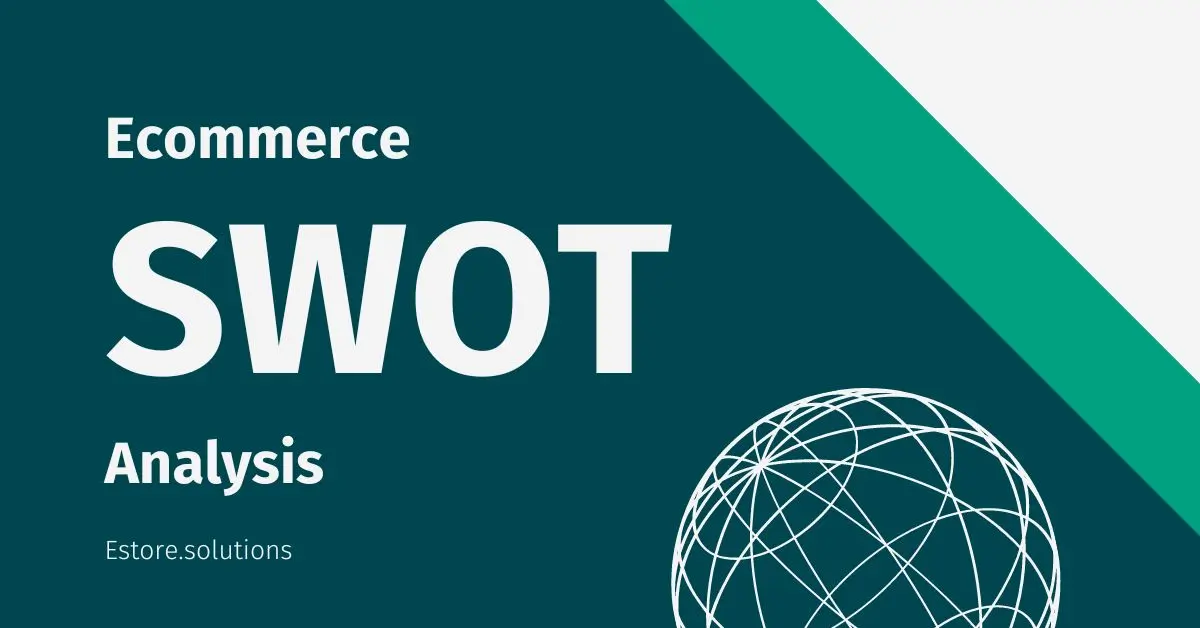Dive into the dynamic world of e-commerce with our comprehensive guide on E-commerce SWOT analysis. Uncover industry-specific examples and strategies to harness strengths, mitigate weaknesses, and capitalize on opportunities, ensuring your online venture thrives.

Share this insightful guide with fellow e-commerce enthusiasts! Your feedback is valuable; visit estore.solutions to share your thoughts and explore content upgrades for an even more enriching experience. Let’s elevate e-commerce success together!
[ez-toc]What is E-commerce SWOT Analysis?
E-commerce SWOT analysis is a strategic tool for online businesses. It pinpoints Strengths, Weaknesses, Opportunities, and Threats, providing a roadmap to optimize strengths, address weaknesses, seize opportunities, and navigate potential threats in the dynamic e-commerce industry.
Why Conduct E-commerce SWOT Analysis?
E-commerce SWOT analysis isn’t just a corporate exercise; it’s a crucial compass for steering your online business toward success. Let’s delve into why it’s indispensable:
Understanding the Competitive Landscape: Gain clarity on how your online store stacks up against competitors, allowing you to capitalize on what makes you unique.
Strategic Planning and Decision Making: Equip yourself with valuable insights for informed decision-making, ensuring your business strategies align with your strengths and opportunities.
Identifying Areas for Improvement: Pinpoint weaknesses and inefficiencies, paving the way for targeted improvements and a more streamlined operation.
Maximizing Opportunities and Mitigating Threats: Stay agile by spotting growth opportunities early and proactively addressing potential threats, ensuring your e-commerce venture remains resilient.
In essence, conducting an E-commerce SWOT analysis is your proactive approach to navigating the complex and dynamic landscape of online business, ensuring you’re equipped to make strategic decisions that drive success.
Where to Apply E-commerce SWOT Analysis?
E-commerce SWOT analysis is a versatile tool applicable at various stages of your online business journey. Consider its strategic application in the following scenarios:
- E-commerce Business Startups: Lay a strong foundation for success by conducting a SWOT analysis at the inception of your online venture. It guides initial strategies and sets the tone for growth.
- Existing E-commerce Businesses: Keep your business on the cutting edge by regularly revisiting your SWOT analysis. Identify evolving strengths, address new weaknesses, and adapt to changes in the competitive landscape.
- Expanding E-commerce Operations: Whether entering new markets or introducing new product lines, SWOT analysis provides a strategic blueprint for expansion, ensuring a well-informed and calculated approach.
In essence, wherever you are on your e-commerce journey – starting, growing, or diversifying – applying E-commerce SWOT analysis equips you with the insights needed to make informed decisions and steer your online business toward sustained success.
Uses of E-commerce SWOT Analysis
E-commerce SWOT analysis serves as a dynamic compass, guiding businesses through the maze of online commerce. Let’s illustrate its uses through an example:
- Evaluating Internal Factors:
- Example: Identify Strengths such as a robust online presence and a loyal customer base. Address Weaknesses like website navigation issues or slow-loading pages.
- Assessing External Factors:
- Example: Explore Opportunities by tapping into a growing market segment or adopting new technologies. Mitigate Threats by staying vigilant against market competition or potential disruptions in the supply chain.
This process ensures a holistic understanding of your e-commerce landscape, enabling you to leverage internal strengths, rectify weaknesses, seize external opportunities, and shield against potential threats. E-commerce SWOT analysis, in this way, becomes a strategic ally in navigating the complexities of the online marketplace.
Benefits of E-commerce SWOT Analysis
Unlocking the potential of E-commerce SWOT analysis yields several tangible benefits, enhancing the strategic prowess of your online business. Let’s break down these advantages:
- Enhanced Decision-Making:
- Example: Armed with insights from the SWOT analysis, decisions become more precise. For instance, understanding the Strengths can guide you in making informed choices on marketing strategies.
- Improved Strategic Planning:
- Example: By acknowledging and addressing Weaknesses, your strategic plans become more resilient. For instance, if website speed is a weakness, your plan might include optimizing the site for better performance.
- Better Risk Management:
- Example: Anticipating Threats allows for proactive risk management. For instance, being aware of potential supply chain disruptions can lead to diversifying suppliers, reducing vulnerability.
- Increased Competitiveness:
- Example: Seizing Opportunities puts you ahead in the competitive race. For instance, identifying a new market segment and catering to its needs can enhance your competitive edge.
In essence, the benefits of E-commerce SWOT analysis are woven into the fabric of strategic decision-making, ensuring your online business not only survives but thrives in a dynamic and competitive digital marketplace.
How to Conduct E-commerce SWOT Analysis
Embarking on an E-commerce SWOT analysis involves a systematic approach to evaluating internal and external factors. Here’s a step-by-step guide:
Internal Analysis –
Strengths
- Website Design and User Experience:
- Evaluate the effectiveness of your website design.
- Consider user-friendliness and ease of navigation.
- Product Range and Quality:
- Assess the variety and quality of products you offer.
- Identify unique selling points (USPs) of your products.
- Customer Service:
- Analyze the quality and responsiveness of your customer service.
- Consider the availability of multiple support channels.
- Brand Reputation:
- Assess your brand’s reputation and customer reviews.
- Consider any awards, certifications, or positive press coverage.
- Marketing and Advertising:
- Evaluate the effectiveness of your marketing strategies.
- Consider the strength of your online presence.
- Technological Infrastructure:
- Assess the efficiency and reliability of your e-commerce platform.
- Consider any innovative technologies you leverage.
Weaknesses
- Website Performance:
- Identify any issues with website speed or functionality.
- Consider user feedback on areas of improvement.
- Inventory Management:
- Evaluate the effectiveness of your inventory management system.
- Identify any challenges in maintaining sufficient stock.
- Customer Acquisition Cost:
- Evaluate the cost of acquiring new customers.
- Identify areas where marketing expenses can be optimized.
- Security Concerns:
- Assess the security measures in place to protect customer data.
- Identify and address any potential vulnerabilities.
- Competitive Positioning:
- Identify areas where competitors have a clear advantage.
- Assess your weaknesses in comparison to industry benchmarks.
- Shipping and Logistics:
- Evaluate the efficiency of your shipping processes.
- Identify any issues with delivery times or shipping costs.
External Analysis –
Opportunities
- Market Trends:
- Identify emerging trends in the e-commerce industry.
- Consider how your business can capitalize on these trends.
- Global Expansion:
- Explore opportunities to expand your business internationally.
- Assess the potential for entering new markets.
- Partnerships and Collaborations:
- Explore potential partnerships with other businesses.
- Consider collaborations that could enhance your product offerings.
- Technology Advancements:
- Stay updated on new technologies that can improve your e-commerce operations.
- Consider integrating innovations like AI, AR, or VR.
- Customer Segmentation:
- Identify niche markets or underserved customer segments.
- Tailor marketing strategies to meet the needs of specific customer groups.
- Diversification of Product/Service Offering:
- Investigate possibilities for broadening your product or service offerings.
- Examine supplementary products that resonate with your brand.
Threats
- Competition:
- Assess the competitive landscape and identify key competitors.
- Consider the threat posed by new entrants.
- Economic Factors:
- Monitor economic conditions that may impact consumer spending.
- Anticipate and ready yourself for potential economic downturns.
- Regulatory Changes:
- Stay informed about any changes in e-commerce regulations.
- Ensure compliance with data protection and consumer rights laws.
- Cybersecurity Threats:
- Be vigilant against potential cyber threats and attacks.
- Invest in robust cybersecurity measures.
- Supply Chain Disruptions:
- Identify potential risks in the supply chain.
- Develop contingency plans for unexpected disruptions.
- Changing Consumer Behavior:
- Stay attuned to shifts in consumer preferences.
- Be adaptable to changes in shopping habits and preferences.
Integration for Comprehensive Insight:
Combine findings from both internal and external analyses to gain a comprehensive understanding. For instance, align strengths with opportunities to maximize growth potential, and address weaknesses in preparation for potential threats.
Examples of E-commerce SWOT Analysis
Understanding how E-commerce SWOT analysis plays out in real-world scenarios can provide valuable insights. Let’s see some case studies:
- Case Study 1: Successful E-commerce Startup
- Strengths: A user-friendly platform, innovative product offerings, and a robust social media presence.
- Weaknesses: Initial logistics challenges and limited brand recognition.
- Opportunities: Identified a niche market and rapidly adapted to emerging trends.
- Threats: Increased competition in the niche and potential supply chain disruptions.
- Case Study 2: Established E-commerce Business
- Strengths: Strong brand reputation, extensive product catalog, and a loyal customer base.
- Weaknesses: Aging website interface and slow adaptation to mobile commerce trends.
- Opportunities: Expanding into international markets and integrating cutting-edge e-commerce technologies.
- Threats: Intense competition from emerging players and potential cybersecurity risks.
These examples showcase how E-commerce SWOT analysis unveils strategic insights, helping businesses capitalize on strengths, address weaknesses, and navigate the complex dynamics of the digital marketplace.
Useful Tools for E-commerce SWOT Analysis
Enhance your E-commerce SWOT analysis with these user-friendly tools and resources:
SWOT Analysis Templates: Streamline your analysis process with ready-to-use SWOT templates available online. These templates offer structured frameworks for organizing your strengths, weaknesses, opportunities, and threats.
Online SWOT Analysis Tools: Leverage online platforms designed specifically for SWOT analysis. Tools like Canva, Lucidchart, and MindMeister offer intuitive interfaces and customizable features to facilitate collaborative SWOT analysis.
Data Analytics Software: Harness the power of data analytics software like Google Analytics, SEMrush, and Moz to gather insights into market trends, consumer behavior, and competitor analysis. Integrating data analytics into your SWOT analysis enhances its depth and accuracy.
These tools empower e-commerce businesses to conduct thorough and insightful SWOT analyses, paving the way for informed decision-making and strategic planning.
Conclusion
In conclusion, mastering E-commerce SWOT analysis is pivotal for navigating the dynamic online marketplace. Regularly assessing strengths, addressing weaknesses, seizing opportunities, and mitigating threats ensures a resilient and competitive e-commerce strategy. Keep evolving to thrive in the ever-changing digital landscape.



